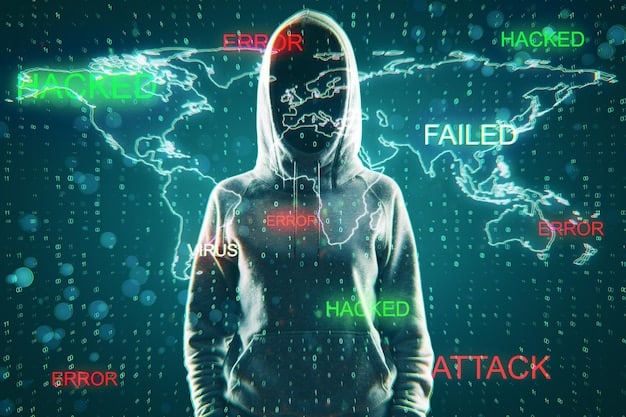Esports Cybersecurity: Protecting Your Organization from Data Breaches and Financial Losses in the US

Esports cybersecurity is crucial for protecting US organizations from data breaches and financial losses by implementing robust security measures, training employees, and staying updated on the latest threats.
In today’s digital age, the esports industry is booming, but this growth also makes it a prime target for cyberattacks. Understanding and implementing robust esports cybersecurity measures is critical for protecting your organization from data breaches and financial losses in the US.
Understanding the Threat Landscape in Esports Cybersecurity
The esports industry faces a unique set of cybersecurity challenges. From player accounts and game servers to sensitive financial data, there are numerous vulnerabilities that cybercriminals can exploit. Being aware of these threats is the first step in protecting your organization.
Common Cybersecurity Threats in Esports
Esports organizations are susceptible to a variety of cyber threats. These can range from simple DDoS attacks to sophisticated phishing schemes. Understanding these threats is essential for building a strong defense.
- DDoS Attacks: Distributed Denial of Service (DDoS) attacks can disrupt game servers and online events, causing significant financial and reputational damage.
- Phishing Attacks: Phishing is used to steal credentials and sensitive information, often targeting players, staff, and administrators.
- Malware Infections: Malware can compromise systems and steal data, leading to financial losses and operational disruptions.
- Account Takeovers: Cybercriminals can take over player accounts, potentially leading to fraud and reputational damage.
The Financial Impact of Cyberattacks
A successful cyberattack can have significant financial repercussions for esports organizations. These costs can include recovery expenses, legal fees, and loss of revenue. Investing in cybersecurity is a proactive measure that can save money in the long run.

In conclusion, understanding the threat landscape is crucial for any esports organization looking to protect its assets and reputation. By identifying the common threats and understanding their potential impact, you can begin to develop a comprehensive cybersecurity strategy.
Implementing Robust Security Measures for Esports Organizations
Implementing robust security measures is paramount for protecting esports organizations from cyber threats. These measures should cover all aspects of the organization, from network security to employee training.
Network Security Best Practices
Securing your network is the foundation of any cybersecurity strategy. This includes implementing firewalls, intrusion detection systems, and other security tools to prevent unauthorized access.
- Firewalls: Firewalls act as a barrier between your network and the outside world, blocking malicious traffic.
- Intrusion Detection Systems (IDS): IDS monitor network traffic for suspicious activity and alert administrators to potential threats.
- Virtual Private Networks (VPNs): VPNs provide a secure connection for remote access, protecting sensitive data from interception.
Data Encryption and Protection
Data encryption is a crucial step in protecting sensitive information. Encrypting data both in transit and at rest can prevent unauthorized access in the event of a breach.
Effective data encryption is essential for maintaining the privacy and security of sensitive information within an esports organization. By implementing strong encryption protocols, organizations can significantly reduce the risk of data breaches and protect their valuable assets.
In conclusion, implementing robust security measures is a multi-faceted approach that requires a combination of technology, policies, and training. By focusing on network security and data protection, esports organizations can significantly reduce their risk of falling victim to cyberattacks.
Training and Educating Employees on Cybersecurity
Human error is a leading cause of cybersecurity breaches. Training and educating employees on cybersecurity best practices is essential for creating a security-conscious culture within your organization.
Creating a Security-Conscious Culture
A security-conscious culture is one where all employees understand the importance of cybersecurity and are proactive in protecting the organization’s assets. This starts with leadership buy-in and ongoing training programs.
- Regular Training Sessions: Conduct regular training sessions to educate employees on the latest cybersecurity threats and best practices.
- Phishing Simulations: Use phishing simulations to test employees’ awareness and identify areas for improvement.
- Security Policies: Develop and enforce clear security policies that outline expectations for employee behavior.
Best Practices for Cybersecurity Awareness
Employees should be aware of common cybersecurity threats and how to avoid them. This includes recognizing phishing emails, using strong passwords, and keeping software up to date.

By investing in employee training and education, esports organizations can significantly reduce their risk of falling victim to cyberattacks. A well-trained workforce is one of the best defenses against cyber threats.
Compliance and Legal Considerations in Esports Cybersecurity
Esports organizations must comply with various data protection laws and regulations. Understanding these requirements and implementing appropriate compliance measures is essential for avoiding legal penalties and maintaining a positive reputation.
Key Data Protection Laws and Regulations
Several data protection laws and regulations can impact esports organizations, including GDPR, CCPA, and other regional and national laws. These laws outline requirements for data collection, storage, and processing.
Understanding and adhering to these regulations is essential for ensuring compliance and protecting the privacy of players, fans, and employees.
Developing a Compliance Program
Developing a comprehensive compliance program can help esports organizations meet their legal and regulatory obligations. This program should include policies, procedures, and training to ensure that data is handled in accordance with applicable laws.
In conclusion, compliance and legal considerations are crucial for esports organizations operating in the US. By understanding the relevant laws and regulations and implementing a comprehensive compliance program, organizations can minimize their legal risks and protect their reputation.
Incident Response and Disaster Recovery Planning
Even with the best security measures in place, cyberattacks can still occur. Having a well-defined incident response plan and disaster recovery strategy is essential for minimizing the impact of a breach and restoring normal operations.
Creating an Incident Response Plan
An incident response plan outlines the steps to take in the event of a cyberattack. This plan should include procedures for identifying, containing, and eradicating the threat, as well as restoring affected systems.
- Identification: Quickly identify the type and scope of the cyberattack.
- Containment: Prevent the attack from spreading to other systems.
- Eradication: Remove the malware or other malicious code from affected systems.
- Recovery: Restore affected systems to their normal operating state.
Developing a Disaster Recovery Strategy
A disaster recovery strategy focuses on restoring business operations after a major disruption. This strategy should include data backups, system redundancy, and a plan for communicating with stakeholders.
In conclusion, incident response and disaster recovery planning are critical components of a comprehensive cybersecurity strategy. By having a well-defined plan in place, esports organizations can minimize the impact of a cyberattack and restore normal operations quickly and efficiently.
Future Trends and Innovations in Esports Cybersecurity
The cybersecurity landscape is constantly evolving, and esports organizations must stay informed about the latest trends and innovations. This includes adopting new technologies and strategies to stay ahead of emerging threats.
Emerging Technologies for Cybersecurity
Several emerging technologies are poised to transform cybersecurity, including artificial intelligence (AI), machine learning (ML), and blockchain. These technologies can help organizations detect and respond to threats more effectively.
Blockchain technology offers innovative solutions for secure data storage and transfer, making it a valuable tool for protecting sensitive information within the esports ecosystem.
Staying Ahead of Emerging Threats
To stay ahead of emerging threats, esports organizations must continuously monitor the cybersecurity landscape and adapt their strategies accordingly. This includes participating in industry forums, sharing threat intelligence, and conducting regular risk assessments.
Ultimately, the key to success in esports cybersecurity is a proactive and adaptive approach that combines technology, training, and collaboration.
| Key Point | Brief Description |
|---|---|
| 🛡️ Network Security | Implement firewalls and intrusion detection systems. |
| 🧑🏫 Employee Training | Educate staff on phishing and security best practices. |
| 🚨 Incident Response | Prepare a plan for cyberattack recovery. |
| 🔒 Data Encryption | Protect sensitive data using encryption methods. |
FAQ
▼
Cybersecurity is crucial for protecting sensitive data, preventing financial losses, and maintaining the reputation of esports organizations. Cyberattacks can disrupt operations and erode trust.
▼
Common attacks include DDoS, phishing, malware, and account takeovers. These attacks can compromise game servers, steal credentials, and disrupt online events causing huge financial losses.
▼
Employees can be trained to recognize phishing attempts, use strong and unique passwords, report suspicious activities immediately, and keep their software updated.
▼
An incident response plan should outline procedures for identifying, containing, eradicating, and recovering from cyberattacks. It should also include communication protocols and roles.
▼
By participating in industry forums, sharing threat intelligence, conducting regular risk assessments, and adopting emerging technologies like AI and blockchain, esports organizations stay cyber protected.
Conclusion
Protecting your esports organization from cyber threats is an ongoing process that requires vigilance, investment, and collaboration. By implementing the strategies outlined above, you can significantly reduce your risk of data breaches and financial losses, ensuring the long-term success of your organization.





